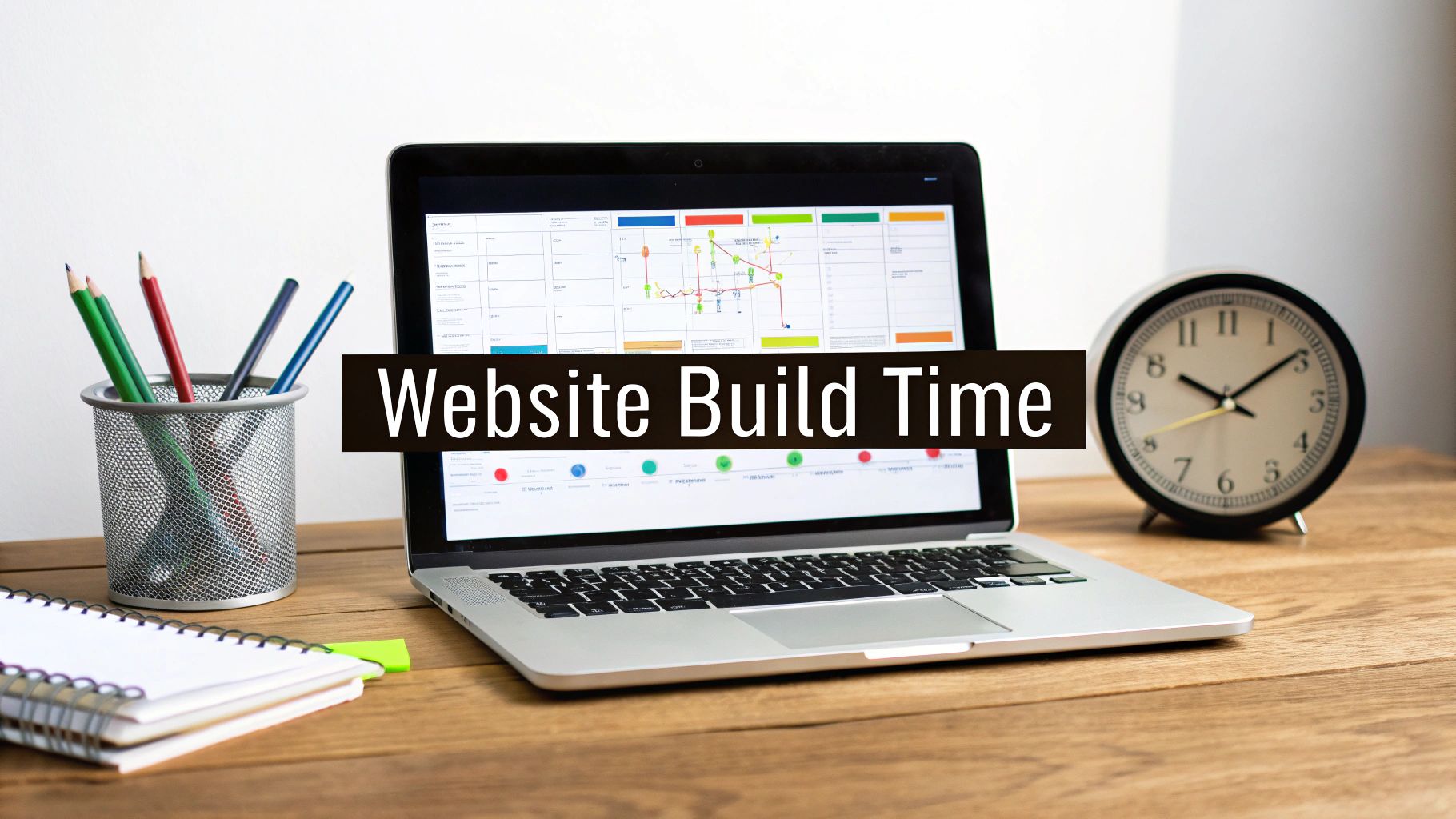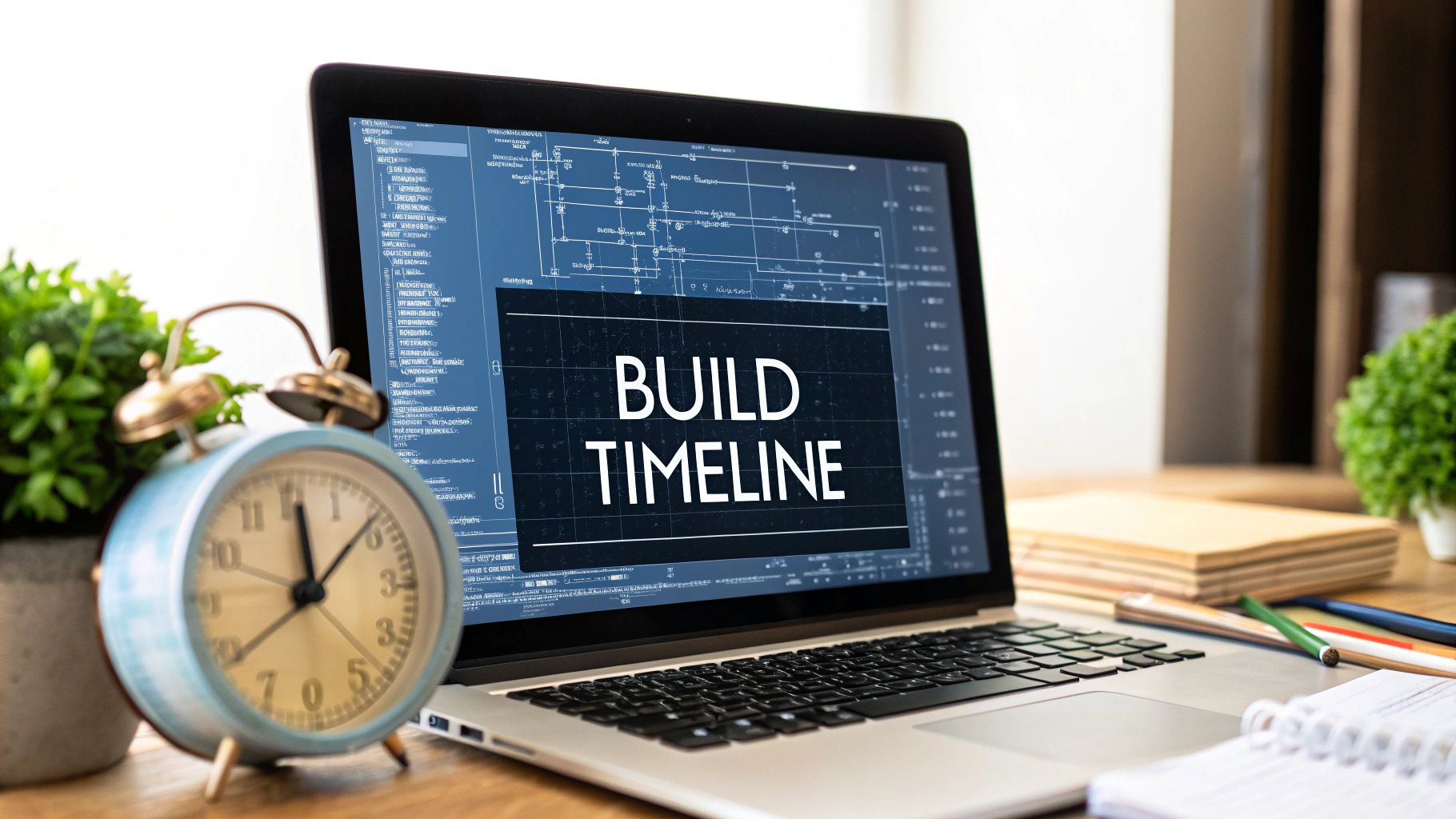
Right, let's get one thing straight before you even think about Googling a web design agency. Jumping into calls without a clear plan is like asking a builder to construct a house without blueprints. You might end up with something, but I guarantee it won’t be what you pictured.
Define Your Project Before You Start Your Search
Before you can find the right partner, you absolutely must define your project first. Honestly, learning how to write a scope of work is the single most important thing you can do at this stage. It’s the foundation for everything that follows.
This bit of prep work does more than just make your search easier; it forces you to get brutally honest about what a "win" actually looks like for your new website. A solid brief becomes your North Star, keeping every decision focused on what really matters for your business.
Start with Your Business Goals
Forget about colours and fonts for a minute. The first question you need to answer is, "What must this website do?" Think of it as a tool, not just a pretty online brochure. Its main job is to deliver tangible results for your business.
So, what are your key objectives? Are you trying to:
Sell more products through an e-commerce store?
Get a steady stream of qualified leads for your service business?
Position your brand as an industry authority?
Make it ridiculously easy for people to book appointments?
Nailing this down clarifies the entire purpose of the site. A website designed for lead generation needs big, obvious contact forms and calls-to-action everywhere. An e-commerce site, on the other hand, lives or dies by its product pages and a checkout process so smooth customers don't even have to think.
Understand Your Target Audience
Here’s a tough pill to swallow: your website isn't for you. It's for your customers. To create a site that people actually enjoy using, you have to get inside their heads.
Sketch out a simple profile of your ideal user. What are their biggest headaches? What are they hoping to find when they land on your site? This insight dictates everything from the site’s navigation to its visual style, making sure the design connects with the right people. This is a big one when choosing an agency—you need a team that gets user-centric design. You can spot the good ones by looking through a strong web design agency portfolio to see how they've solved problems for other clients.
Before you start shortlisting agencies, it helps to understand what kind of specialisation you actually need. Not all agencies are created equal, and finding the right fit is crucial.
Agency Specialisation Quick-Check
This table breaks down the most common types of agencies to help you match your project goals with the right kind of expertise.
Agency Type | Best For | Key Focus | Typical Project Example |
|---|---|---|---|
Boutique/Creative Agency | Businesses wanting a unique, brand-forward design. | Visual identity, branding, and high-impact aesthetics. | A fashion brand's new collection launch site. |
Full-Service Digital Agency | Companies needing an integrated marketing strategy. | Web design, SEO, PPC, social media, and content marketing. | A B2B firm looking for lead generation and online visibility. |
E-commerce Specialist | Retailers focused on online sales. | Shopping cart functionality, payment gateways, and conversion optimisation. | A direct-to-consumer brand launching a new online store. |
Technical/Development Agency | Businesses with complex functional requirements. | Custom code, API integrations, and web application development. | A startup building a custom software-as-a-service (SaaS) platform. |
Knowing the difference saves you from pitching your e-commerce project to a boutique branding agency that doesn't handle complex payment integrations.
List Your Must-Have Functionalities
Okay, now it’s time to turn your goals and audience needs into a practical list of features. Don't worry about getting super technical. Just think about what your website needs to do.
Key Takeaway: A detailed feature list is non-negotiable. It wipes out all the guesswork for agencies, which means you get far more accurate quotes. More importantly, it helps you avoid "scope creep"—that dreaded moment when project requirements magically expand, taking your budget with them.
The web design industry in the UK is fiercely competitive, with over 2,000 active agencies all fighting for attention. It's a big market, pulling in around £621.3 million in revenue, which tells you just how much businesses value a quality website. In a space this crowded, clarity is your secret weapon.
Once you have that clear brief, you're in a much stronger position to start your search. You'll know exactly what you're looking for, and you'll be able to spot the right partner when you find them.
How to Critically Evaluate Agency Portfolios

An agency’s portfolio is their CV. It's the best evidence you've got to judge what they can actually do. But just flicking through pretty pictures won't cut it. To really figure out how to choose the right web design agency, you need to look past the slick visuals and analyse their work like a detective.
Think of their portfolio less like an art gallery and more like a collection of business case studies. Every project should tell a story: here was the problem, here's our clever solution, and here are the results. Your job is to find that story and see if they’re the right people to write yours.
Look for Results, Not Just Resumes
A beautiful website is nice. A beautiful website that doubles a client's leads? Now that's powerful. When you're scrolling through a portfolio, your first filter should be for tangible business results. An agency that knows its salt will show this off.
They won't just say, "We built a new website for Company X." They’ll give you the juicy details. Hunt for case studies that spell it out clearly:
The Challenge: What specific problem was the client facing? (e.g., "Their old site had a bounce rate of 80% and was useless for mobile visitors.")
The Solution: What did the agency actually do? (e.g., "We built a mobile-first design with dead-simple navigation and unmissable calls-to-action.")
The Results: What measurable impact did it have? (e.g., "This dropped their bounce rate by 40% and boosted online bookings by 25% in three months.")
This stuff is gold. It proves the agency doesn't just make things look good; they solve business problems. If a portfolio is all style and no substance, that’s a massive red flag.
Expert Tip: Don't be afraid to ask for the numbers. If a case study feels vague, push for the metrics. A confident agency that delivers real results will have the data and won't be shy about sharing it.
Assess Versatility and Adaptability
Next up, check their stylistic range. Does every single website in their portfolio look suspiciously similar? A one-trick-pony agency might be fine if you absolutely love their one style, but it’s a problem if they try to shoehorn your unique brand into their cookie-cutter template.
A top-tier agency is a chameleon. Their portfolio should show they can create distinct visual identities for different clients and industries. One project might be sleek and corporate for a law firm, while another is bright and playful for a kids' brand. This versatility shows they actually listen to their clients and design for the target audience, not just for their own creative ego. Getting this right is a cornerstone of great design. In fact, for a deeper dive, you might find our guide on the 10 commandments of web design helpful.
Analyse User Experience and Functionality
While you're clicking through their past work, pay close attention to how the sites feel to use. Don't just look at screenshots. Get on the live websites and pretend you're a customer.
Ask yourself these simple questions as you navigate:
Is it intuitive? Can you find what you’re looking for easily, or are you clicking around in circles? The navigation should make perfect sense.
Is it responsive? Pull the site up on your phone. Does it still look great and work properly? A non-responsive site is a total non-starter these days.
Is it fast? How long does it take to load? Google found that 53% of mobile users will ditch a site if it takes longer than three seconds. Slow websites literally cost businesses money.
Are the calls-to-action (CTAs) clear? Does the website practically grab you by the hand and lead you to "Request a Quote," "Buy Now," or "Contact Us"? Effective sites have a purpose.
This hands-on test gives you direct insight into their commitment to user experience (UX). A great portfolio is full of sites that aren't just pretty, but are also functional, fast, and a pleasure to use. That's what turns visitors into customers.
By digging deeper, you get past the sales pitch and see what an agency can truly deliver. It’s this critical eye that helps you find a partner who will build a genuine, results-driven asset for your business.
Getting a Feel for an Agency’s Process and Workflow
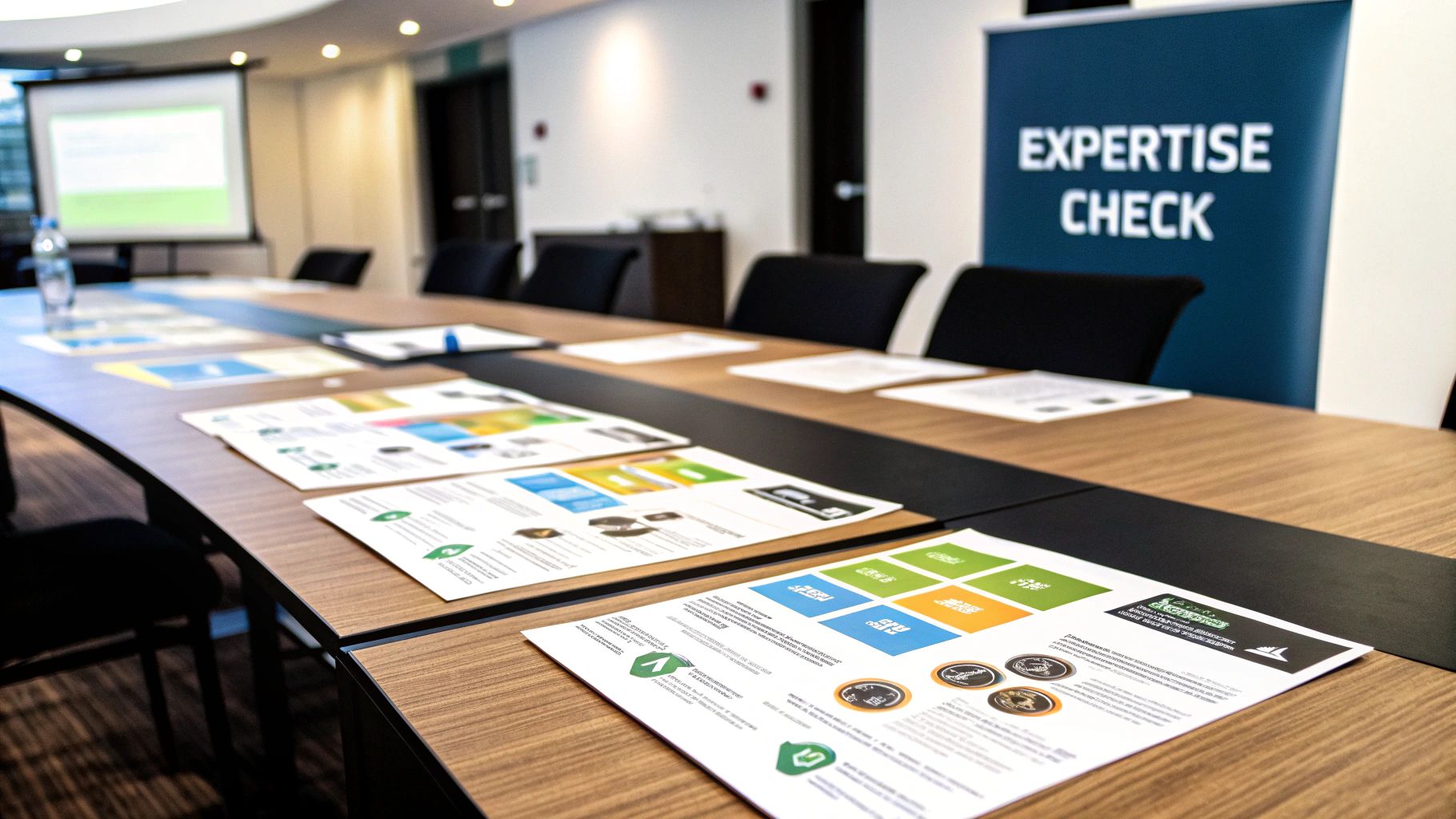
The shiny new website is the destination, but the journey to get there? That’s just as important. A messy, disorganised process can turn an exciting project into a nightmare, leading to missed deadlines and a final product that looks nothing like you imagined. When you’re figuring out how to pick a web design agency, you need to dig into how they work, not just what they’ve made.
Finding an agency whose rhythm matches yours is the key to a smooth partnership. You’re not just buying a website; you’re starting a collaboration. Things tend to fall apart when there are mismatched expectations about communication or project management.
The Typical Project Journey (No, Really, It’s a Thing)
While every agency adds its own unique flavour, any professional web design process follows a pretty predictable path. You should be looking for a structured approach that moves from one phase to the next, with clear milestones where you get to have your say.
If an agency can’t explain their process clearly, consider it a massive red flag.
Here’s what a standard project usually looks like:
Discovery & Strategy: This is the groundwork. The agency should be asking you a ton of questions to really get under the skin of your business, goals, audience, and competitors. It all ends with a clear project plan.
Wireframing & UX Design: Before they even think about colours, they’ll create blueprints (wireframes) of your website. This is all about structure and user flow, making sure the site is easy to navigate before it’s pretty.
Visual Design & UI: Now for the fun part. Once the blueprint is approved, the designers bring it to life with your branding, colours, and images to create the website's look and feel.
Development: This is where the approved designs are coded into a real, functioning website. The front-end (what people see) and back-end (the engine) are built and connected.
Testing & QA: The agency should be relentlessly testing the site across different browsers and devices to find and squash bugs. Everything has to work perfectly.
Launch & Handover: Your new website goes live! A good agency won’t just disappear; they’ll give you training on how to manage your shiny new site.
How They Talk and How They Work
Knowing the stages is one thing, but how the agency manages them—and you—is everything. Miscommunication kills more projects than anything else, so you need to feel confident they’ll keep you in the loop.
A transparent process isn't just a nice-to-have; it's what keeps your project on time and on budget. You should never, ever feel like you're in the dark about what's happening.
To get a real sense of their workflow, you need to ask some direct questions about their day-to-day operations. This isn’t just about the small details; it reveals how professional they are and how much they value working with you. Understanding this is a huge part of uncovering the secrets of savvy website design from a client's point of view.
Don’t Be Shy—Ask These Questions About Their Process:
Who will be my go-to person? Having a dedicated project manager is a game-changer. Juggling multiple contacts is a recipe for chaos.
What project management tools do you use? Do they use something like Asana, Trello, or Basecamp? It shows they’re organised and not just winging it with emails.
How often will we catch up? Do they do weekly check-in calls, or is it all done by email? Find a rhythm that works for you.
How do you handle feedback and changes? You need to know their process for feedback and, crucially, how many rounds of revisions are included in the price.
The bigger picture in the UK matters, too. With 96% of households in Great Britain having internet access by 2020, the pressure is on for businesses to have incredible websites. In fact, the UK web design industry is on track to hit £658.2 million in revenue by 2025, with many agencies now using AI to create more personalised designs. When you choose a partner, make sure they’re keeping up with new tech to give you an edge.
A clear, well-managed process is the foundation of a great client-agency relationship. When you find a team that not only does amazing work but also guides you through a transparent and collaborative journey, you've struck gold.
Decoding Proposals to Understand the Real Cost
When a few proposals from web design agencies finally hit your inbox, it's tempting to scroll straight to the bottom and compare the final numbers. But hold on. The cheapest quote is almost never the best value.
To figure out what you're really getting for your money, you need to treat these documents like a detective. A proposal is more than a price tag; it’s a window into how an agency works and whether they’ve actually listened to you. Vague proposals are a breeding ground for messy projects and surprise invoices.
Looking Beyond the Grand Total
First things first: stop comparing the final figures. Instead, start comparing the line items. A detailed cost breakdown isn't a "nice to have," it's a must. If an agency sends you a proposal with a single number for "Website Design," you need to push back for more detail. Immediately.
What should a good breakdown include?
Costs by phase: Look for separate figures for discovery, design, development, and testing. This shows they have a structured process.
Specific deliverables: Does the proposal list exactly what’s included? Think things like "5-page website design," "custom contact form," or "e-commerce product page setup."
The tech stack: It should mention the platform they plan to use, whether that’s Wix, WordPress, or something custom. This choice will affect your site's flexibility and future costs.
A great proposal leaves zero room for doubt. This level of detail protects you from scope creep and ensures you're comparing apples with apples across different agencies.
Scrutinising the Scope of Work
The scope of work is the real heart of the proposal. It should read like a perfect summary of your project brief. If it feels generic or like a copy-and-paste job, it’s a huge red flag that the agency hasn’t been paying attention.
A solid scope document outlines every single feature and function. If you asked for a blog, does it say so? If you need an events calendar, is it listed in black and white? Vague promises like "user-friendly navigation" mean nothing. You want specifics, like "a five-item main menu with dropdowns for services."
Pro Tip: When you're evaluating agency proposals, it's essential to understand the contractual terms. For those without a legal background, learning how to approach reviewing contracts as a non-lawyer can be incredibly helpful in spotting potential issues before you sign.
Remember, this document will become part of your contract, so it has to be spot-on. Any grey areas now can turn into major disagreements later on.
Uncovering Hidden and Ongoing Costs
The initial project fee is just one part of the financial picture. A truly professional agency will be upfront about the costs you'll face after your shiny new site goes live. If these aren't mentioned in the proposal, it's on you to ask.
Make sure you get clear answers on these ongoing expenses:
Website Hosting: Who provides it, and what's the annual cost?
Domain Name Renewal: Is this included, or is it your responsibility to handle?
Maintenance Plans: What do they offer for ongoing security updates, backups, and tech support? What are the monthly or annual fees?
Licensing Fees: Will your site use any premium plugins or software that need to be renewed every year?
These recurring costs can add up fast. Knowing them upfront helps you budget properly and avoid any nasty surprises a year down the road. An agency that lays all these cards on the table from the start is one that's building trust and looking for a long-term partnership.
Ultimately, picking the right web design agency often comes down to the quality of their proposal. Take your time, ask a ton of questions, and go with the partner who gives you the most clarity and value—not just the lowest price.
Assessing Technical Skill and Future-Proofing
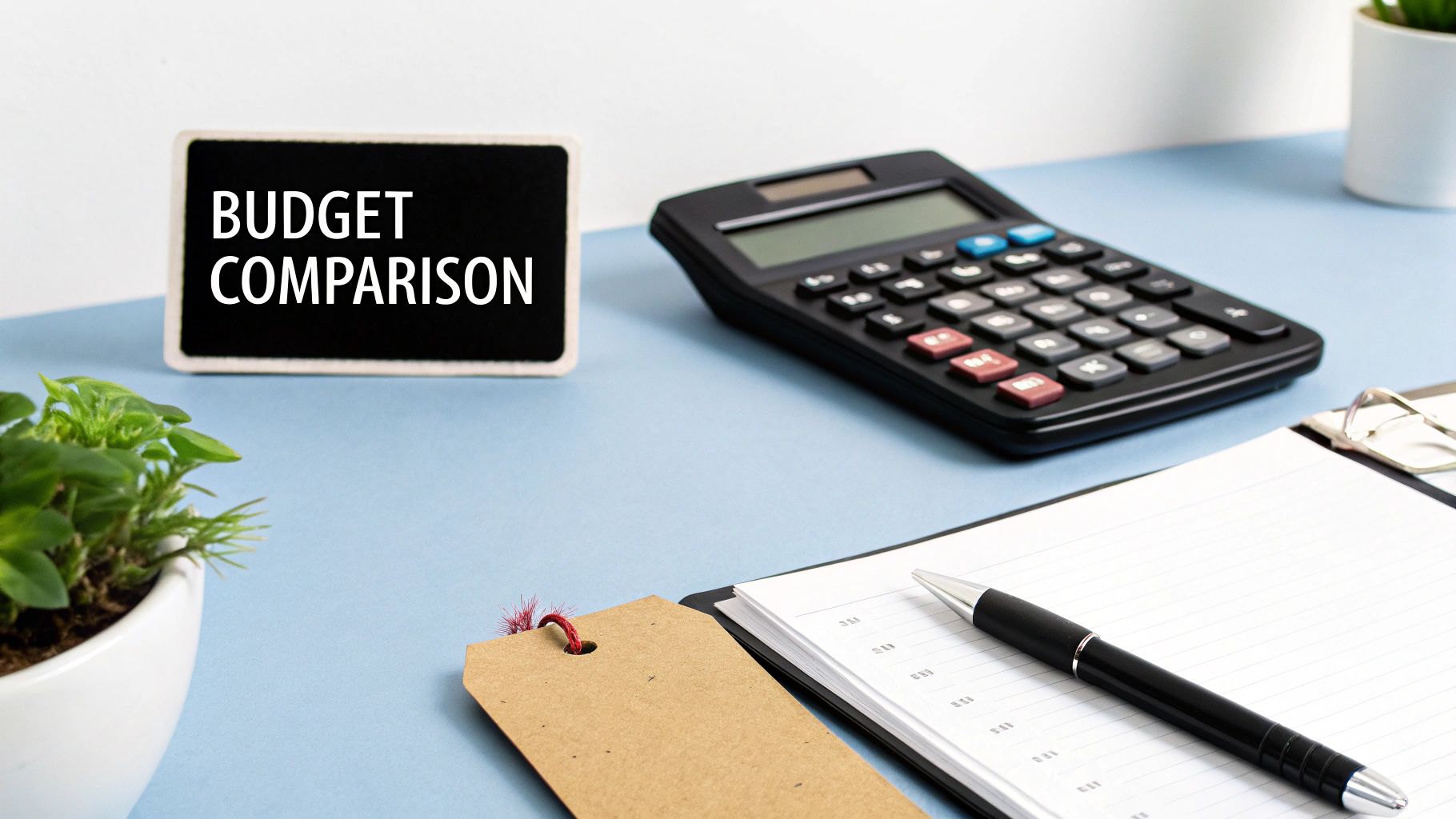
A stunning website that doesn’t actually work is like a sports car with no engine. It looks the part, but it’s going nowhere. To really figure out how to choose a web design agency, you’ve got to pop the bonnet and check their technical skills.
This is about making sure your investment is built on solid ground—a foundation that’s secure, fast, and not going to be obsolete next year. Your website isn't a static brochure; it's a living, breathing part of your business that needs to grow with you.
The Mobile-First Mindset
It's no longer enough for a website to just "work" on a phone. With more than half of all web traffic now coming from mobile devices, a "mobile-first" approach isn't a trendy buzzword—it's the only way to build.
This means the agency should be designing the mobile version of your site first, before even thinking about the desktop layout. This forces them to focus on what’s essential, ensuring the core experience is lightning-fast and intuitive for the majority of your users.
Ask them straight up about their mobile-first process. If they get shifty or sound like mobile is an afterthought, that’s a massive red flag.
The Great CMS Debate: WordPress vs Custom Solutions
The Content Management System (CMS) is the engine room of your site. It’s what lets you update a blog post or change a price without having to call a developer. The agency’s preferred platform will have a huge impact on your site's flexibility, security, and running costs.
Let's break down the usual suspects:
WordPress: It powers a ridiculous portion of the internet for a good reason. It’s incredibly flexible, has a massive support community, and offers plugins for pretty much anything you can dream up. The downside? Its popularity makes it a juicy target for hackers if it’s not properly looked after.
Hosted Builders (like Wix): Platforms like Wix offer an all-in-one package with hosting, security, and design tools baked in. This makes them ridiculously user-friendly for business owners who want to manage their own site without getting a computer science degree. At Baslon Digital, we specialise in Wix because it lets us build gorgeous, high-performing sites that our clients can actually update with confidence.
Custom-Built CMS: For super-specific or complex needs, an agency might suggest building a CMS from scratch. This gives you ultimate control, but it comes with a much, much bigger price tag and locks you into that one agency for future support.
The key takeaway here is that there's no single "best" CMS—only the best one for your needs, your budget, and how comfortable you are with the tech side of things. A good agency will justify their recommendation based on your goals, not just what they prefer to use.
Planning for a Scalable Future
Your business isn’t going to stand still, so why should your website? Scalability means your site can handle growth without needing a complete, soul-destroying rebuild. It’s not just about handling more visitors; it’s about being able to bolt on new features without the whole thing collapsing.
Imagine your service business decides to launch an online shop in a year's time. A scalable website can integrate e-commerce features without a fuss. A site that wasn't built with growth in mind might grind to a halt, forcing you to start from scratch. This kind of foresight is what separates the pros from the amateurs.
The UK's digital economy is absolutely booming, with projections showing a staggering 62 million e-commerce users by 2025. With over 2,130 web design agencies competing for attention in the UK, finding one that builds for the future is vital.
A forward-thinking agency ensures your website is an asset ready for tomorrow's opportunities, not a relic of yesterday's tech. You can find more insights on the UK web design agency market on duck.design.
By asking these technical questions, you’re making sure your new website will be a robust, future-proofed machine that drives your business forward for years.
Making the Final Decision and Kicking Off Your Project
You've sifted through portfolios, decoded proposals, and asked all the tough questions. Now you're staring at a shortlist of strong contenders, and the final choice can feel a bit daunting. This is where you switch from gut feelings to a more objective analysis to pick the right agency with total confidence.
After weeks of research, it's easy for all the details to blur together. To cut through the noise, whip up a simple scoring matrix in a spreadsheet. List your shortlisted agencies across the top and your key criteria down the side. This simple tool turns a "who did I like best?" decision into a data-driven one.
Creating Your Decision Matrix
Give each agency a score from 1 to 5 for each of your criteria. This forces you to critically compare them on the points that actually matter to your business.
Your criteria list might look something like this:
Portfolio Quality: Did their past work align with your aesthetic and functional needs?
Case Study Results: Were there clear, measurable results for past clients? Or just pretty pictures?
Technical Expertise: How confident were you in their answers about CMS, scalability, and mobile-first design?
Process Transparency: Was their project workflow clear and collaborative, or a bit of a mystery?
Communication & Culture Fit: Did you actually get on with them during your calls?
Proposal Clarity: How detailed and transparent was their quote and scope of work?
Tallying up the scores often reveals a clear winner. If two agencies are neck and neck, that "culture fit" score can be the perfect tiebreaker. You’ll be working closely with this team for months, so a positive relationship is a massive plus.
The Final Due Diligence: Checking References
Before you sign on the dotted line, there's one last crucial step: checking references. Any reputable agency will happily give you the contact details for a few recent clients. Speaking directly to someone who's been through their process offers invaluable, unfiltered insight.
Don't just ask if they were "happy" with the result. Dig a bit deeper with specific questions:
How did the agency handle unexpected challenges or feedback?
Was the project delivered on time and within the agreed budget?
How has the website performed since it launched?
Would you hire them again?
This final check validates everything the agency has promised and gives you the peace of mind to move forward.
Kicking Off Your Project for Success
You've made your choice. Fantastic. Now the focus shifts to starting the project on the right foot. A strong kickoff sets the tone for the entire collaboration and makes sure everyone is aligned from day one. A messy start can create friction that’s hard to recover from.
This decision tree shows how communication preferences can guide you toward setting the right expectations with your new agency.
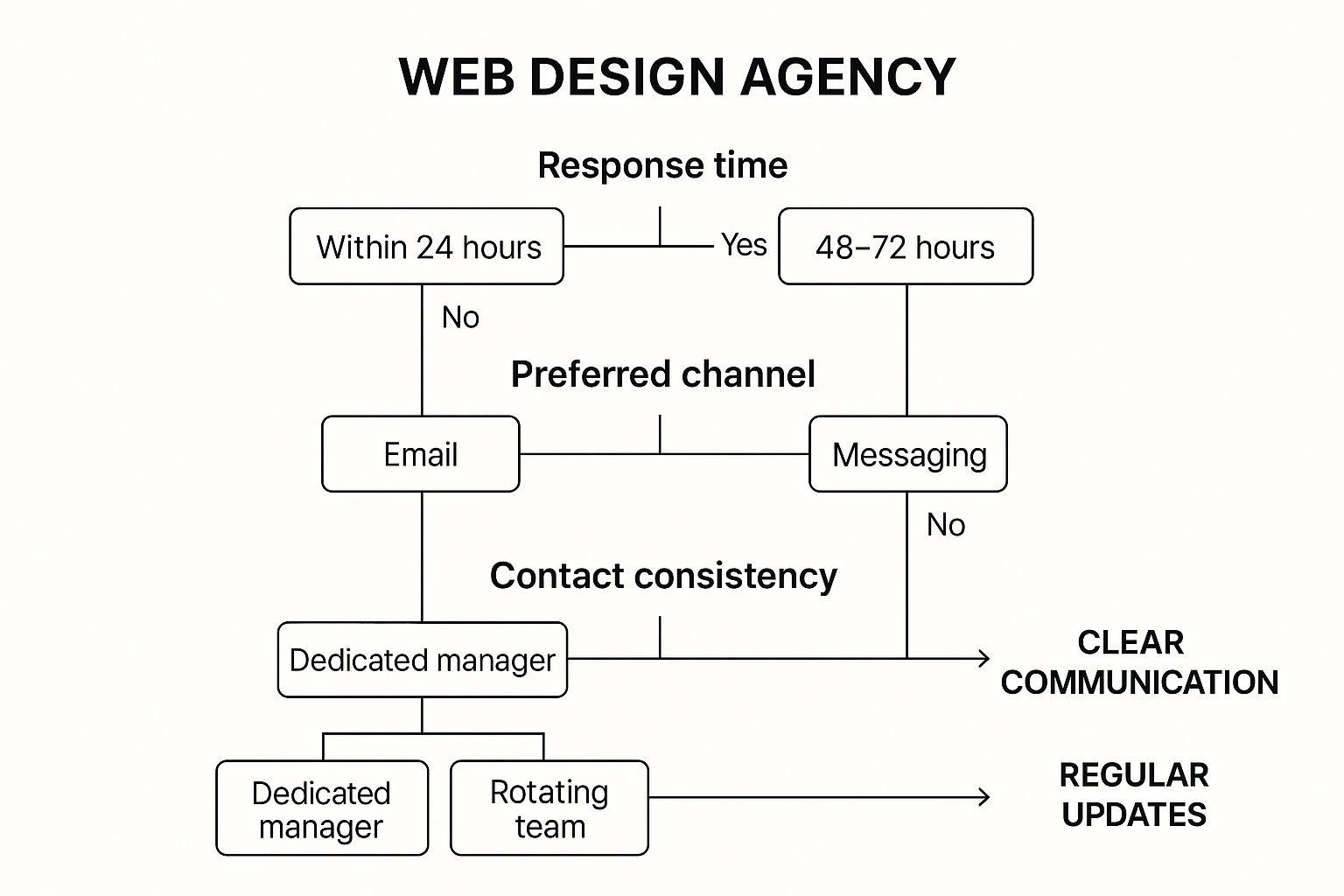
Key Takeaway: A successful project isn't just about the final website—it's about a partnership built on clear communication, shared expectations, and a structured process. The onboarding phase is your first opportunity to establish these foundations.
Your pre-launch checklist should cover the essential next steps to ensure a seamless transition from prospect to partner.
Finalise the Contract: Read the agreement one last time. Make sure the scope of work, timeline, payment schedule, and deliverables all match up with what you've discussed.
Set Up Communication Channels: Agree on your primary communication tool, whether it’s a project management system like Asana, a shared Slack channel, or just regular email updates.
Schedule the Kick-Off Meeting: This is the official start. The agenda should include introducing the key players on both sides, running through the project goals and timeline, and confirming the next immediate steps.
Choosing a web design agency is a significant investment. By following a structured process, you move from just hoping for a good outcome to actively engineering one, landing a true partner who will help your business thrive.
Ready to partner with an agency that combines stunning design with a clear, collaborative process? Baslon Digital specialises in creating high-performing Wix websites that get results.
Get Your Free, No-Obligation Quote Today
Article created using [Outrank](https://outrank.so)

